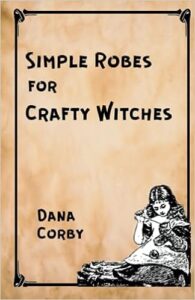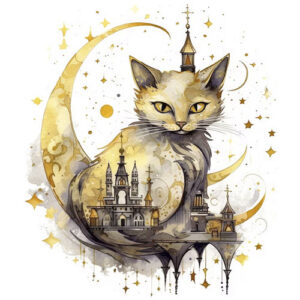
 The Rantin’ Raven Art & Publishing
The Rantin’ Raven Art & Publishing
ISBN: 979-8853818040
As a life-long sewer, it gives this reviewer great pleasure to see Dana Corby’s simple, direct, and useful instructions for creating comfortable robes for ritual wear. That there is a need for such instructions reflects the loss of basic skills that endless generations before us deemed essential for daily living. Not everyone has the interest, or even the patience to endure high school home economics classes in sewing, or the extra money and leisure time to take sewing classes independently. The art and craft of garment construction seems daunting to many people, especially anyone who has ever sat at the pattern reference table in Joann’s and flipped through a Vogue Patterns look-book. Yet it need not be, and the author lays out elegant, flowing garments that are timeless and create virtually no waste.
The hippie movement Ms. Corby references took their inspiration from European, African, and Asian folk garments whose basic cutting lines were essentially geometric, and wasted little or no fabric. That tradition harks back to the era of handwoven fabric, an expensive commodity, and hand-sewn and hand-embellished garments. Such garments spanned the globe, from Morocco to Japan, Scandinavia to India. The Society for Creative Anachronism dubbed one such garment “the basic T-tunic,” so-called because it literally resembles a capital T.
Instructions for hand-sewing note the need to take small stitches, and to back-stitch in order to lock the seam in place. For the student making their first robe, hand-sewing may seem daunting, but the rhythm of poking the needle repeatedly through the fabric can have a trance-like effect, and that in itself helps to set the intention into the garment. Lest anyone think that hand-sewn garments are completely a thing of the past, consider this: High-end garments from Parisian haute couture design houses such as Dior, and the finely tailored outfits on Savile Row in London, are largely created by hand to this day.
Ms. Corby notes the greatest stumbling block to creating robes: the relative dearth of good fabrics in natural fibers, and the scarcity of local retailers. If readers cannot find a Joann’s in their area, look for specialty quilting shops. These will invariably have an excellent selection of fabrics in 100% cotton. Most of these fabrics will have the same sort of hand as a cotton percale bed sheet, but occasionally softer, more drapey fabrics such as batiste and lawn can be found. These can be sheerer than the basic quilting cotton, so making a simple under-tunic is a smart idea.
There are three points that should be emphasized when buying 100% cotton and linen, and even these fibers blended with rayon. One is that buying an extra half-yard or even a full yard is a wise precaution. This is because of the second point which is that, when the sewer pre-washes the fabric, as Ms. Corby recommends, the fabric will likely shrink in washing and drying. The looser the weave, the greater the chance that the fabric will shrink. The third point is that a ritual robe needs to be flame-safe. This does not mean that it needs to be treated with flame-resistant chemicals. Rather, it needs to be made from natural fibers that char into ash, rather than melt, as polyester and nylon do. Fabrics made with a blend of cotton or linen with rayon are generally safe, as rayon is also a cellulosic fiber that will char when burned.
One suggestion that was alluded to, and could help the sewer find colors that are not locally available, is to shop online. Some online retailers will sell swatches of fabric, no more than 6 inches square, so that the purchaser can have an idea of the hand, or drape, of the fabric, and how the color actually looks. Once a selection has been made, the appropriate yardage can then be ordered. Two manufacturers sell directly online, and their fabrics are excellent: Mood Fabrics and Robert Kaufman Fabrics. Pendleton also sells wool yardage online.
Ms. Corby’s book is a fine primer for those new to sewing, and for those who are experienced sewers of street apparel using commercial sewing patterns, but have not tried to cut a garment without a pattern. This is a far easier project than most non-sewers might think. Ms. Corby has demystified the process admirably.
 E. S. Hudson has been a practicing witch-priestex for over thirty years. They hold an MA in History from Shippensburg University and reached ABD status in History at the University of Texas at Austin. They began sewing and doing other needle arts as a child, and progressed to garment construction as a teenager, and continues sewing to this day. They are also an artist, working in watercolor, gouache, and acrylic, and handspinner and weaver.
E. S. Hudson has been a practicing witch-priestex for over thirty years. They hold an MA in History from Shippensburg University and reached ABD status in History at the University of Texas at Austin. They began sewing and doing other needle arts as a child, and progressed to garment construction as a teenager, and continues sewing to this day. They are also an artist, working in watercolor, gouache, and acrylic, and handspinner and weaver.